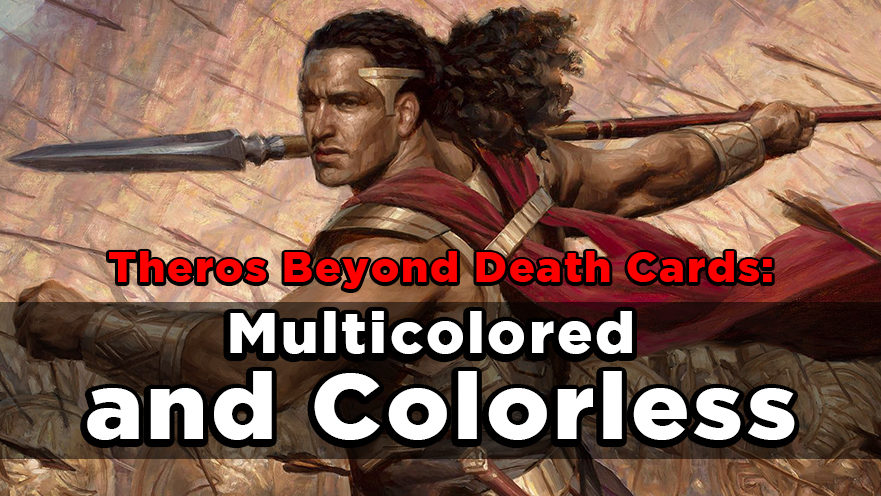We have reached the end of our journey, friends. After several weeks of hype, speculation and analysis, this is the last article in Card Kingdom’s review of Theros Beyond Death! We have covered the implications, quirks and uses of cards in red, white, blue, black and green — so today, we’re wrapping up with artifacts and multicolored cards. These are some of the most powerful and complex cards in the set, so let’s close out this series on a high note!
ASHIOK, NIGHTMARE MUSE
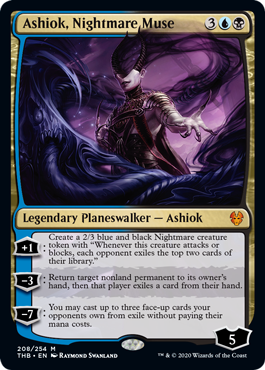
Ashiok features prominently in the story of Elspeth’s rise from the underworld of Nyx, so it makes sense that they would also have a marquee mythic rare in the set. Ashiok, Nightmare Muse is from the classic pre-War of the Spark school of Planeswalker designs: a five-mana bomb with a +1 which creates incremental advantage, a -3 to deal with a permanent, and an ultimate which to some degree reads: “win the game over a turn or two.”
Ashiok can ultimate within three turns, making them a very real threat which demands immediate answers. Most Planeswalkers with this sort of speed have “plus” abilities which don’t protect themselves to compensate, but Ashiok generates solid 2/3 blockers which threaten to fuel their ultimate! And unlike the similar Ashiok, Nightmare Weaver, this Ashiok can use their ultimate to cast cards which an opponent had exiled for any reason.
With the opportunity to play cards like Despark and Epic Downfall in control decks — and with the escape mechanic entering Magic formats along with Ashiok — you should have all the fuel you need to make Ashiok ultimates lethal! And yes, this includes the cute lore-friendly combo with Ashiok’s Erasure — you can counter a spell, cast it with an Ashiok ultimate, then reset the Erasure with Teferi, Time Raveler if your opponent still wants to keep playing.
KLOTHYS, GOD OF DESTINY
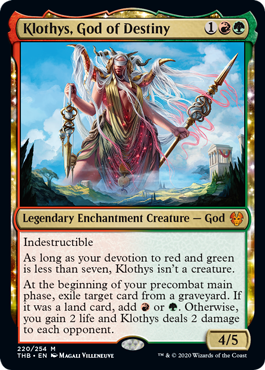
Disrupting the evenness of the new god cycle is Theros Beyond Death’s only two-color God. (Besides Athreos, that is, but we’ll get to him later!) Klothys is interesting to compare to her mono-colored kin — her ability has the lowest impact on the battlefield, so it’s essential to bring her online as a creature. On the other hand, RG is almost certainly the color combination most able to turn on and use a 4/5 indestructible God early in the game. The deck plays almost all permanents, and its creatures tend to be big enough to survive and provide devotion. In that sense, Klothys is a mostly-reliable attacker and a main-deck-able source of reach — essentially, the anti-control card that some players hoped Cindervines would be.
This focus on her combat stats doesn’t mean Klothys is bad as an enchantment, though. While a three-mana investment is a lot in older formats, the Deathrite Shaman-like ability to hose graveyards while providing resources is attractive to anyone playing a long game. In decks like Ponza, Klothys is a cheap option to commit to the board (Bloodbraid Elf can cascade into her!), which will help win a resource war while whittling down an opponent’s life. Plus, she threatens to come alive at a moment’s notice to finish them off. A worthy replacement for Xenagos who will see play everywhere.
URO, TITAN OF NATURE’S WRATH
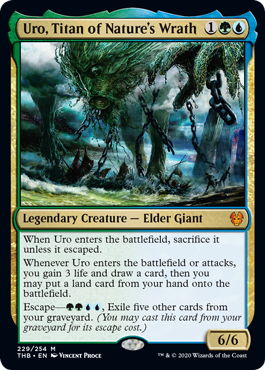
It’s impossible not to imagine the kind of UG decks which would currently exist in Standard were 2019 not such a year for bannings. Oko, Thief of Crowns, Once Upon a Time, Veil of Summer, Nissa, Who Shakes the World, Gilded Goose, Wicked Wolf, Hydroid Krasis… and Uro, Titan of Nature’s Wrath. The curve is obscenely powerful and consistent, ramping out resources ahead of schedule while providing constant pressure and rarely even spending cards. Fortunately, we get to play against a much-watered-down version of this terror, but Uro is still going to leave a real mark on Standard before he’s done.
Uro and his fellow titan Kroxa are oddly templated, but essentially they are split cards: a sorcery you cast from hand for their printed cost, and then a creature which can only escape from your graveyard. While Hushbringer and Tale’s End shenanigans could allow you to circumvent the escape requirement, the titans are so efficiently costed that it’s almost a waste to have those cards taking up slots in your deck. Even without self-mill, paying 1GU for Growth Spiral plus three life is essentially fine. Any loss of board control is offset by the knowledge that you’re about to put a 6/6 into play!
Uro is potentially even more brutal in Pioneer. He has better graveyard support to ensure he escapes early and often, but is still safe from being humbled by Path to Exile. The already-strong “Dredge-less Dredge” deck gains another consistent way to trigger Prized Amalgam, as well as a way to replenish resources without slowing down. The most inevitable deck in the format now has an extra fifteen life per game while generating another must-exile threat. Grab a playset of Rest in Peace — you certainly won’t be beating Uro in a fair game!
KROXA, TITAN OF DEATH’S HUNGER
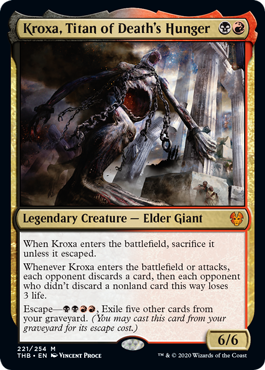
Though similar to his brother Uro in most respects, Kroxa’s design is a bit more tame. Discard effects are just less consistently impactful than effects that grant free resources, and neither the slight mana discount on casting cost nor the life loss rider makes up for that. What Kroxa does have going for him are his colors. Considering the play pattern of these titans, BR is well-suited to load the graveyard, take advantage of the initial cast from hand, and apply pressure around an early 6/6. Uro looks unstoppable in the long game, but Kroxa is far more likely to pick up an Embercleave and immediately win!
As effectively a four-mana bomb, Kroxa is positioned as a curve topper in the typical BR aggro deck. A discard spell is nice for an archetype which would appreciate any free card advantage. But rather than take a turn off playing creatures, most decks would prefer to loot the titan away with something like Rix Maadi Reveler. If you do happen to hard-cast Kroxa, make sure you leverage his evoke-like wording by sacrificing him to Priest of Forgotten Gods before his trigger resolves!
Of course, Kroxa and Uro also make interesting commanders. You can choose to sacrifice them back to the command zone repeatedly, or you can allow them to go to the yard once they’re ready to escape. Kroxa’s trigger hits the whole table, which makes him a natural fit for a Punisher/Group Slug-style deck.
CALIX, DESTINY’S HAND
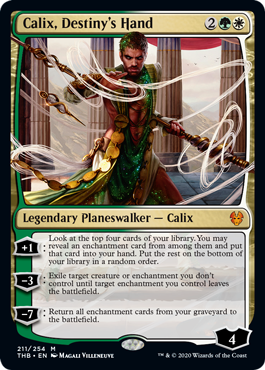
Calix seems like an attempt to do for enchantments what various Tezzeret and Saheeli cards have done for artifacts. Estrid, the Masked was awesome, but aura-specific, and as a Commander precon card, she isn’t legal in most Constructed formats. So Calix is here to ensure we see enchantments front and center in Theros Beyond Death Standard.
I think this card mostly succeeds in that, providing effects most valuable to enchantment decks and to Calix’s colors. White will greatly appreciate access to card selection and advantage from his +1, while base-green decks can use him in place of Banishing Light if they have some good options to tie his -3 to. The ability to make any enchantment into an Oblivion Ring is an especially nice touch, reminiscent of Palace Jailer in that it creates a valuable effect which can outlast Calix himself. And of course, this is another ultimate which should always be game-breaking. Replenish is one of the more powerful sorceries ever printed, and when all the re-entering enchantments trigger constellation, the value here should be just as good.
As a side note, Calix looks like another fantastic argument for Wizards to change the official ruling to allow Planeswalkers as commanders. You can always house-rule within your group to allow him in the meantime — I think he’s by far the best option to ensure consistency in a GW Enchantress deck and has a perfect play pattern for Commander!
POLUKRANOS, UNCHAINED
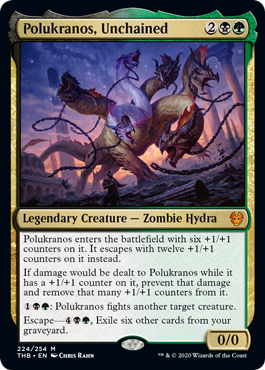
While the concept and art of this card are truly awesome, I do wonder how many high-escape-cost mythics can be supported in one set. Polukranos looks like a fantastic deal, but without any keywords for its gigantic body, it’s certainly more of a board-control card for midrange mirrors. Depending on what the format’s doing, this may not scale with the game UGx Ramp is playing — one giant creature can only get you so far, regardless of how giant it is.
Polukranos, Unchained could be cool as a secondary option for Reanimator decks, like the Drakuseth/Bond of Revival deck I’ve played to success throughout the last few sets of Standard. For a deck doing that much self-milling, it would be nice to have a way to harness the graveyard; unlike the titans with their “escape-only” clause, Polukranos can give you a spare target for Bond in a pinch (like if you run out of cards to escape with, or want it to be hasty). Having a reasonable casting cost and specializing in board control also help smooth out the archetype’s more embarrassing draws, and could save you having to play Ritual of Soot main-deck.
ATHREOS, SHROUD-VEILED
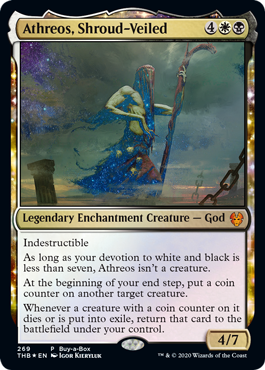
As the Buy-A-Box mythic, Athreos might be easily overlooked. But like many of these promos, he edges close enough to Constructed playability to be worth a mention.
Athreos is a fun finisher option for WB enchantment decks. He provides a source of incremental advantage that’s more resilient than Archon of Sun’s Grace or Aphemia and punchier than Ethereal Absolution. No color combination has creature removal like WB, and with Athreos, all those Banishing Lights and Kaya’s Wraths pull you ahead. Against creatureless decks, you at least have an indestructible 4/7 to slowly beat down with, and the coin counters can go on your own creatures to blank opposing removal. If the wording had only allowed you to put coin counters on enchantments, I think this would have been a slam dunk.
Where Athreos, Shroud-Veiled is nearly-guaranteed to see play is Commander. You can go heavy on white’s exiling enchantments and play a slow game, and abuse Eldrazi Displacer or other flickering effects like Parallax Wave to steal creatures without spending cards. The major limitation is the rate at which Athreos places his coin counters, which is frustratingly hard to work around. If you enjoy slower, grindier decks, then the Shroud-Veiled may be your new favorite God.
HAKTOS THE UNSCARRED
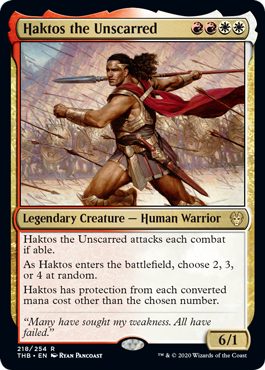
Here, we are blessed with the Therosian Achilles. The 6/1 statline may look painful on a four-drop, but keep in mind that the Unscarred’s protection clause prevents him being damaged or even blocked unless your opponent can find his, uh, “Haktos’s Elbow.” If they can’t pinpoint an answer, then their only recourse is a non-damaging sweeper or forced-sacrifice effect. And with six damage a turn steaming in, they don’t have much time to find one.
Haktos has a lot going for him even outside Standard. Guaranteed protection from one mana has huge cachet in eternal formats, where he can also be smuggled past countermagic with Aether Vial or Cavern of Souls. He has the extremely relevant Human type, and lines up favorably against Karakas or creature tokens. I suspect he will also make a great aggressive Commander for a disruptive RW Hatebears list.
Now, for a few sobering realities about the protection clause. You can’t equip Embercleave to Haktos, nor can you enchant him with auras unless they happen to match his vulnerable number. You cannot shield your Haktos with Mother of Runes or Giver of Runes. You also usually can’t buff him with Planeswalkers or creatures like Aurelia, Exemplar of Justice. The new red removal spell, Purphoros’s Intervention, can scale its X value to always hit his weakness, and is good enough to see play in Standard main decks.
And if you somehow obtain a Haktos with no number chosen for its ability, he ends up with protection from nothing, not protection from everything. Sorry, Lazav fans — guess you’ll have to settle for copying Kroxa and Uro!
ATRIS, ORACLE OF HALF-TRUTHS
This article would not be complete without featuring the set’s dark horse card. Atris looks positively puny for four mana compared to Uro or Haktos, keeling over to a Stomp or even Disfigure! But in a set where so many of the best plays require fueling your graveyard and games are going long, Atris is the reliable source of card advantage and battlefield presence that UBx decks need.
He first turned heads as a four-of in high-performing Esper Hero lists, and is now being tested in all sorts of midrange decks. Atris is also a subtle bomb in Limited, as the format focuses heavily on escape cards across all colors and Omen of the Dead is an efficient, common way to recur him. Fact or Fiction effects always bring fun decision-making to Magic, so I’m glad that this one seems to be playable for Standard.
SHADOWSPEAR
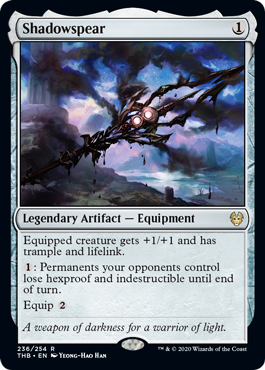
Elspeth’s new weapon is a sleeker, more specialized tool than Godsend, and will be welcomed into Commander decks of all colors. I struggle to see this in Standard, although if the Gods or Dream Trawler become totally rampant, this does provide a mana-efficient answer even in decks with no creatures to equip. It may also sneak into more creative builds of the white lifegain aggro deck, as it looks particularly good strapped to an Ajani’s Pridemate.
The most significant part of Shadowspear is the lifelink, which is still relatively difficult to find outside of white and black. Of the five other equipment to offer the keyword, Behemoth Sledge is color-restricted, Butcher’s Cleaver is type-restricted, and Batterskull and Loxodon Warhammer demand cumbersome mana investments. Playing for one and equipping for two lines Shadowspear up nicely alongside Basilisk Collar; while trample has slightly less utility than deathtouch, there are still many commanders (such as Jaya Ballard, Task Mage) who will welcome the additional source of lifelink.
THEROS BEYOND SPOILERS
And so concludes a busy and exciting month of Magic! By now, I’m sure most of you have had the chance to play with cards from Theros Beyond Death, and a meta is slowly taking shape as grinders rush to test new archetypes. Thanks for reading this series — I hope you’ve enjoyed our tour through the most prominent and exciting options the set has to offer!

Tom’s fate was sealed in 7th grade when his friend lent him a pile of commons to play Magic. He quickly picked up Boros and Orzhov decks in Ravnica block and has remained a staunch white magician ever since. A fan of all Constructed formats, he enjoys studying the history of the tournament meta. He specializes in midrange decks, especially Death & Taxes and Martyr Proc. One day, he swears he will win an MCQ with Evershrike. Ask him how at @AWanderingBard, or watch him stream Magic at twitch.tv/TheWanderingBard.

